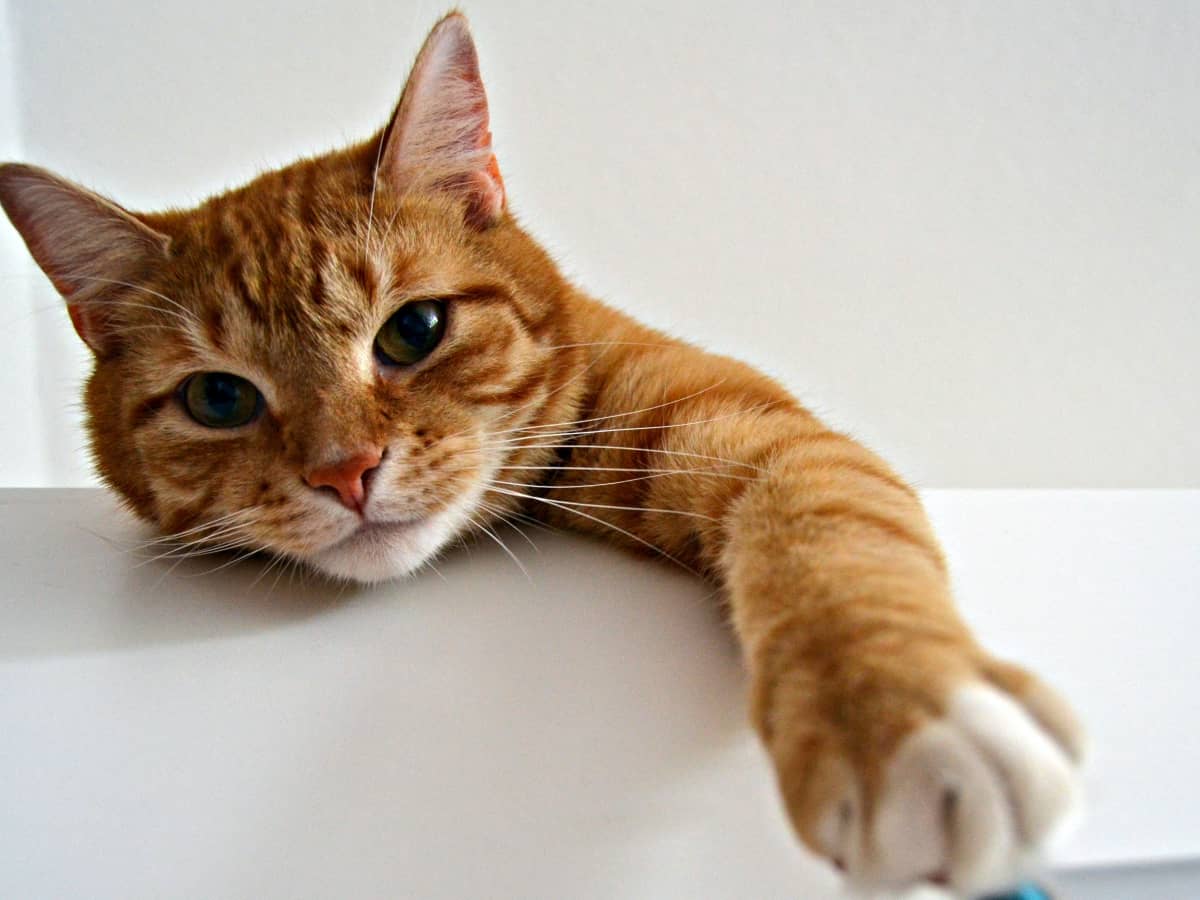How to help your cat put their best paw forward? As cherished companions, cats bring joy, comfort, and companionship to millions of households around the world. Yet, despite their independent nature, cats rely on their owners for essential care and support to thrive. From providing nutritious meals to creating enriching environments, there are numerous ways to ensure that our feline friends lead happy and fulfilling lives. One crucial aspect of cat care often overlooked is maintaining their paw health. Just as humans depend on their feet for mobility and well-being, a cat’s paws are vital to their overall health and happiness. From grooming to nail trimming, understanding how to care for your cat’s paws is essential for promoting their physical and emotional well-being. In this guide, we’ll explore various tips and techniques to help your cat put their best paw forward, ensuring they remain happy, healthy, and comfortable for years to come.
How to Help Your Cat Put Their Best Paw Forward
By incorporating regular grooming sessions into your cat’s routine, you not only ensure their physical well-being but also strengthen the bond between you and your furry companion. From keeping their fur sleek and shiny to tending to their nails and ears, grooming offers numerous advantages beyond just aesthetics. In this guide, we’ll explore the essential steps and techniques to help your cat put their best paw forward. Whether you’re a seasoned cat owner or a novice, this comprehensive resource will equip you with the knowledge and skills necessary to elevate your cat’s grooming experience to new heights. Get ready to embark on a journey of care and companionship as we delve into the world of feline grooming together.
Step 1: Establish a Comfortable Environment
Introduction: Creating a comfortable environment is essential for promoting your cat’s well-being and ensuring their happiness in your home.
Key Considerations:
- Cozy Resting Areas: Provide your cat with comfortable bedding or cat trees where they can relax and nap undisturbed.
- Clean Litter Box: Maintain a clean litter box by scooping waste daily and changing litter regularly to prevent odors and promote good litter box habits.
- Access to Water: Ensure your cat has access to fresh, clean water at all times to stay hydrated and healthy.
- Enrichment Opportunities: Offer stimulating toys, scratching posts, and climbing structures to keep your cat mentally and physically engaged.
- Safe Haven: Create hiding spots or elevated perches where your cat can retreat if they feel stressed or overwhelmed.
Result: By providing a comfortable environment tailored to your cat’s needs, you promote their overall well-being and happiness in your home.
Step 2: Proper Nutrition
Introduction: Proper nutrition is fundamental for maintaining your cat’s health, vitality, and longevity.
Key Considerations:
- Selecting Quality Food: Choose a high-quality cat food that is nutritionally balanced and appropriate for your cat’s life stage, such as kitten, adult, or senior.
- Balanced Diet: Ensure your cat’s diet includes essential nutrients, vitamins, and minerals to support their overall health and development.
- Portion Control: Monitor your cat’s food intake and avoid overfeeding to prevent obesity and associated health problems.
- Consultation with Veterinarian: Seek guidance from your veterinarian to determine the best diet plan for your cat based on their individual needs, medical history, and lifestyle.
- Hydration: Encourage your cat to drink an adequate amount of water to prevent dehydration, especially if they consume dry food.
Result: By providing proper nutrition tailored to your cat’s specific requirements, you support their overall health, immune function, and vitality throughout their life.
Step 3: Regular Exercise
Introduction: Regular exercise is crucial for maintaining your cat’s physical health, mental well-being, and overall happiness. By providing opportunities for play and movement, you can help your cat stay active and engaged.
Methods:
- Toy Selection: Offer a variety of toys that stimulate different types of play, such as interactive toys, feather wands, and laser pointers.
- Play Sessions: Set aside dedicated time each day for active play sessions with your cat. Engage them in activities like chasing toys, pouncing on feather wands, or exploring cat tunnels.
- Outdoor Exploration: If it’s safe and feasible, allow your cat supervised outdoor time to explore and exercise in a secure environment. Consider using a harness and leash for controlled outdoor adventures.
- Vertical Space: Provide vertical spaces for climbing and perching, such as cat trees or shelves mounted on walls. Cats enjoy climbing and observing their surroundings from elevated vantage points.
- Rotate Toys: Keep playtime exciting by rotating your cat’s toys regularly to maintain their interest and prevent boredom.
Results: Regular exercise helps your cat maintain a healthy weight, prevents obesity-related health issues, reduces stress and anxiety, and fosters a strong bond between you and your pet. By incorporating fun and engaging activities into your cat’s daily routine, you can promote their overall well-being and quality of life.
Step 4: Socialization
Introduction: Socialization is essential for ensuring that your cat feels comfortable and confident in various environments and social situations. By exposing them to different experiences and interactions from a young age, you can help prevent fearfulness and aggression.
Methods:
- Early Exposure: Introduce your cat to various people, animals, sights, sounds, and smells during their critical socialization period, which typically occurs between 2 and 7 weeks of age.
- Positive Associations: Use treats, praise, and play to create positive associations with new experiences and stimuli. Reward calm and confident behavior in unfamiliar situations.
- Gradual Introductions: Introduce your cat to new people, pets, and environments gradually, allowing them to adjust at their own pace. Provide plenty of opportunities for retreat and reassurance if they feel overwhelmed.
- Consistent Socialization: Continue socializing your cat throughout their life by exposing them to new experiences and interactions regularly. Reinforce positive behaviors and gently correct any undesirable behaviors.
- Monitoring Body Language: Pay attention to your cat’s body language and behavior to gauge their comfort level and intervene if necessary. Look for signs of stress, such as dilated pupils, flattened ears, or excessive hiding.
Results: Proper socialization helps your cat feel confident, relaxed, and secure in various situations, reducing the likelihood of fear-based aggression or anxiety-related behavior problems. By providing positive and enriching social experiences, you can help your cat develop into a well-adjusted and sociable companion.
Step 5: Grooming
Introduction: Regular grooming is essential for maintaining your cat’s physical health and appearance. By establishing a grooming routine, you can help prevent skin issues, matting, and discomfort for your feline friend.
Methods:
- Brushing: Use a soft-bristled brush or comb to gently remove loose hair and prevent mats and tangles in your cat’s fur. Brushing also helps distribute natural oils, keeping the coat shiny and healthy. Start with short grooming sessions and gradually increase the duration as your cat becomes more comfortable.
- Nail Trimming: Trim your cat’s nails regularly to prevent them from becoming overgrown and causing discomfort or injury. Use cat-specific nail clippers and be cautious not to cut the quick, which can cause bleeding and pain. Offer treats and praise to make nail trimming a positive experience for your cat.
- Ear Cleaning: Check your cat’s ears regularly for signs of dirt, wax buildup, or infection. Use a damp cotton ball or a veterinarian-recommended ear cleaner to gently clean the outer ear. Avoid inserting anything into the ear canal, as this can cause injury.
- Eye Care: Keep your cat’s eyes clean by gently wiping away any discharge or debris with a damp cotton ball or soft cloth. If you notice excessive tearing, redness, or irritation, consult your veterinarian for further evaluation.
- Dental Health: Maintain your cat’s dental health by providing dental treats, toys, or regular teeth brushing with a cat-specific toothbrush and toothpaste. Dental issues can lead to pain, infection, and other health problems, so it’s essential to prioritize oral hygiene.
Results: Regular grooming promotes your cat’s overall well-being by keeping their coat clean and free of mats, preventing nail overgrowth, and addressing potential grooming-related issues promptly. By incorporating grooming into your cat’s routine, you can strengthen your bond and ensure a happy and healthy life for your furry companion.
Step 6: Environmental Enrichment
Introduction: Environmental enrichment plays a crucial role in keeping your cat mentally stimulated, physically active, and emotionally fulfilled. By providing a stimulating and engaging environment, you can prevent boredom, reduce stress, and encourage natural behaviors. How AI, ChatGPT maximizes earnings of many people in minutes
Methods:
- Interactive Toys: Offer a variety of toys that encourage play and mimic hunting behaviors, such as wand toys, feather teasers, and puzzle feeders. Rotate toys regularly to keep your cat engaged and prevent boredom.
- Vertical Space: Create vertical space for your cat to climb, perch, and observe their surroundings. Install cat trees, shelves, or window perches to provide elevated vantage points and opportunities for exploration.
- Scratching Posts: Provide multiple scratching posts or pads throughout your home to satisfy your cat’s natural scratching instincts and keep their claws healthy. Choose scratching surfaces made of materials like sisal rope or cardboard.
- Hideouts and Retreats: Offer hiding spots and cozy retreats where your cat can escape and relax when they need privacy or solitude. Use cat beds, boxes, or tunnels to create safe and comfortable spaces for your cat to retreat to.
- Outdoor Enclosures: If safe and feasible, consider providing access to an outdoor enclosure or catio where your cat can experience the sights, sounds, and smells of the outdoors in a controlled environment.
Results: Environmental enrichment enhances your cat’s quality of life by providing opportunities for physical activity, mental stimulation, and emotional fulfillment. By enriching your cat’s environment, you can prevent behavioral problems, promote natural behaviors, and strengthen the bond between you and your feline companion.

Step 7: Positive Reinforcement
Introduction: Positive reinforcement is a valuable training technique that involves rewarding your cat for exhibiting desired behaviors. By using rewards such as treats, praise, and affection, you can encourage your cat to repeat these behaviors and strengthen your bond with them. Motivation – Mind – Success – Thinking – Productivity – Happiness
Methods:
- Identify Desired Behaviors: Determine which behaviors you want to encourage in your cat, such as using the litter box, coming when called, or being calm during grooming sessions.
- Use Rewards Consistently: When your cat performs the desired behavior, immediately reward them with a treat, verbal praise, or a gentle petting session. Use a consistent cue word or clicker to mark the behavior and signal that a reward is coming.
- Be Patient and Consistent: Training takes time and patience, so be consistent in your approach and avoid getting frustrated if progress is slow. Break training sessions into short, frequent sessions to keep your cat engaged and focused.
- Avoid Punishment: Never punish your cat for unwanted behaviors, as this can cause fear, anxiety, and aggression. Instead, redirect their attention to a more appropriate behavior and reward them for making the right choice.
- Keep it Fun: Make training sessions enjoyable for your cat by incorporating play, treats, and interactive toys. Keep the atmosphere positive and upbeat to motivate your cat to participate willingly.
Results: By using positive reinforcement techniques, you can effectively train your cat to exhibit desired behaviors while strengthening your bond with them. Positive reinforcement creates a positive association between good behavior and rewards, making training sessions enjoyable for both you and your feline companion.
Step 8: Veterinary Care
Introduction: Regular veterinary care is essential for maintaining your cat’s health and well-being. Routine check-ups and preventive care help detect and prevent medical issues early, ensuring your cat enjoys a long, happy life. Business – Money Making – Marketing – E-commerce
Methods:
- Schedule Regular Check-ups: Schedule annual wellness exams with your veterinarian to assess your cat’s overall health, monitor for any changes or concerns, and update vaccinations.
- Parasite Prevention: Keep your cat up to date on parasite-prevention medications to protect against fleas, ticks, heartworms, and intestinal parasites. Follow your veterinarian’s recommendations for preventive treatments.
- Dental Care: Practice good dental hygiene by brushing your cat’s teeth regularly and providing dental treats or toys to help reduce plaque and tartar buildup. Schedule professional dental cleanings as recommended by your veterinarian.
- Nutrition and Weight Management: Feed your cat a balanced diet that meets their nutritional needs and helps maintain a healthy weight. Avoid overfeeding and monitor your cat’s body condition score to prevent obesity and associated health issues.
- Prompt Medical Attention: Seek veterinary care promptly if you notice any signs of illness or injury in your cat, such as changes in appetite, lethargy, vomiting, diarrhea, or difficulty breathing. Early intervention can improve treatment outcomes and prevent complications.
Results: Regular veterinary care is essential for ensuring your cat’s health and well-being throughout their life. By prioritizing preventive care and seeking prompt medical attention when needed, you can help your cat live a long, happy, and healthy life.
Step 9: Stress Management
Introduction: Managing stress is crucial for promoting your cat’s overall well-being and ensuring they feel safe and comfortable in their environment. By implementing stress management techniques, you can help your cat cope with changes, reduce anxiety, and promote a sense of security. Health books, guides, exercises, habits, Diets, and more
Methods:
- Provide Safe Spaces: Create designated areas in your home where your cat can retreat and relax when they feel stressed or anxious. This could include cozy beds, hiding spots, or elevated perches where they can observe their surroundings.
- Use Calming Pheromones: Consider using synthetic pheromone products, such as diffusers, sprays, or collars, to help create a calming environment for your cat. These products mimic natural pheromones that cats release when they feel safe and secure, helping to reduce stress and anxiety.
- Minimize Disruptions: Try to minimize disruptions and changes to your cat’s routine whenever possible. Stick to a consistent feeding schedule, litter box routine, and playtime schedule to provide structure and stability in their daily lives.
- Provide Enrichment: Offer enrichment activities, such as puzzle feeders, interactive toys, and scratching posts, to keep your cat mentally stimulated and engaged. This can help distract them from stressful situations and provide an outlet for their natural behaviors.
- Monitor for Signs of Stress: Be vigilant for signs of stress or anxiety in your cat, such as hiding, excessive grooming, changes in appetite, or aggression. If you notice any concerning behaviors, take steps to address the underlying cause and provide support to help your cat feel more comfortable.
Results: By implementing stress management techniques, you can help your cat feel more secure and comfortable in their environment, reducing the risk of stress-related health issues and promoting overall well-being.
Step 10: Preventive Care
Introduction: Preventive care is essential for maintaining your cat’s health and preventing common illnesses and health problems. By staying proactive and prioritizing preventive measures, you can help your cat live a long, healthy, and happy life. Fitness – Meditation – Diet – Weight Loss – Healthy Living – Yoga
Methods:
- Routine Vaccinations: Keep your cat up to date on vaccinations to protect against common infectious diseases, such as rabies, feline leukemia, and distemper. Follow your veterinarian’s recommended vaccination schedule based on your cat’s age, lifestyle, and risk factors.
- Parasite Prevention: Use preventive medications to protect your cat from fleas, ticks, heartworms, and intestinal parasites. Administer monthly flea and tick preventives, as well as regular deworming treatments, to keep parasites at bay and prevent infestations.
- Dental Care: Practice good dental hygiene by brushing your cat’s teeth regularly and providing dental treats or toys to help reduce plaque and tartar buildup. Schedule professional dental cleanings as recommended by your veterinarian to maintain your cat’s oral health.
- Regular Veterinary Check-ups: Schedule annual wellness exams with your veterinarian to assess your cat’s overall health, monitor for any changes or concerns, and address any preventive care needs. Be proactive in seeking veterinary care if you notice any signs of illness or injury in your cat.
- Maintain a Safe Environment: Keep your home clean and free of hazards to reduce the risk of accidents, injuries, and exposure to toxins. Store household cleaners, medications, and other potentially harmful substances out of your cat’s reach, and supervise outdoor excursions to prevent accidents or encounters with wildlife.
Results: By prioritizing preventive care measures, you can help protect your cat from common illnesses and health problems, ensuring they enjoy a long, healthy, and happy life by your side.
Step 11: Observation and Communication
Introduction: Observation and communication are vital components of understanding and meeting your cat’s needs. By paying attention to your cat’s behavior and body language, you can better understand their preferences, moods, and overall well-being. RPM 3.0 – 60% CONVERSION & Money for Affiliate Marketing
Methods:
- Observe Body Language: Pay attention to your cat’s body language, including their posture, tail movements, and vocalizations. These cues can provide valuable insights into how your cat is feeling and what they may need.
- Listen to Vocalizations: Cats use a variety of vocalizations to communicate, from meows and purrs to chirps and hisses. Learn to interpret your cat’s vocalizations and respond accordingly.
- Provide Opportunities for Communication: Create opportunities for interaction and communication with your cat through play, grooming, and affectionate interactions. Respond to their cues and signals with patience and understanding.
- Respect Their Boundaries: Be respectful of your cat’s boundaries and preferences. If they indicate that they want space or are not in the mood for interaction, give them the time and space they need.
- Build Trust: Establishing trust is essential for effective communication with your cat. Be consistent, reliable, and respectful in your interactions, and avoid behaviors that may erode trust, such as punishment or aggression.
Results: By honing your observation skills and fostering open communication with your cat, you can strengthen your bond and provide them with the care and support they need to thrive.
Step 12: Patience and Understanding
Introduction: Patience and understanding are fundamental qualities for building a strong and fulfilling relationship with your cat. As unique individuals with their personalities and preferences, cats require patience and empathy to thrive in their environment. Cat accessories on Amazon
Methods:
- Respect Individuality: Recognize and respect your cat’s personality traits and preferences. Allow them to express themselves in their way and avoid imposing unrealistic expectations on them.
- Be Patient in Training: Training takes time and repetition, so be patient and consistent in your efforts. Avoid becoming frustrated or impatient if progress is slow, and celebrate small victories along the way.
- Acknowledge Challenges: Understand that building a bond with your cat may come with challenges and setbacks. Approach these challenges with patience, understanding, and a willingness to learn and adapt.
- Provide Support: Offer your cat support and reassurance during stressful or unfamiliar situations. Be a source of comfort and security for them, and help them navigate new experiences with confidence.
- Celebrate Milestones: Celebrate the milestones and achievements you reach together as you build your relationship. Whether it’s mastering a new trick or simply sharing a quiet moment of affection, cherish these moments and continue to nurture your bond.
Results: By practicing patience and understanding in your interactions with your cat, you can cultivate a strong and enduring relationship built on trust, respect, and mutual appreciation.
Other Interesting Articles
- How to Make Your Cat Really Happy: 29 Tips You May Try
- How to Train Your Cat to Stop Urine Marking? 12 Tips
- How Do Cats Communicate Each Other? 11 Body Language
- 24 Ways To Know If You Have An Extremely Happy Cat
- What Smells Do Cats Hate: 34 Scents You Must Avoid
- Everything You Need To Know About Cat Territory Marking
- 12 Reasons Why You Should Adopt A Second Cat
- 12 Reasons Cats Pee Outside the Litter Box: How To Solve
- 14 Reasons Why Cats Overgroom: Surefire Ways To Stop It
- Why is My Cat So Clingy? 13 Common Signs: 9 Caring Tips
- Is Your Cat Bored? 12 Common Signs: What You Can Do
- Stress in Cats: Causes, Symptoms, Remedies, Treatment
- 17 Common Signs Your Cat is Lonely: 10 Tips To Help Recover
- 14 Reasons My Cat is Acting Strange & Scared: What to Do?
- How Do Cats Hunt Their Prey, Mice, Bird, Fish, Rat For Food?
- How To Introduce A New Kitten To An Older Cat: 16 Tips
- 15 Reasons Why Do Cats Lick and Groom Each Other
- Domesticated Cats And Big Cats: 24 Similarities, Differences
- 21 Interesting Facts You Should Know About Feral Cats
- How to Socialize a Feral Kitten in 10 Simple Steps



